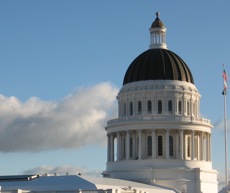Just a couple of weeks back, some stalwarts still held out hope for a federal climate bill this summer. But with the capitulation by congressional leaders on Thursday, this week the legislative landscape looks undeniably bleak. And with flagging expectations for multinational climate talks, the heat is now turned up once again on the so-called “sub-national” actors, like states and provinces. It also lends more gravitas to efforts like Governor Schwarzenegger’s announced third climate summit for sub-national leaders, scheduled for November at UC Davis.
 Just as Congress was throwing in the towel, the non-partisan World Resources Institute issued a timely report that aims to sum up the potential impact of state and regional climate efforts in the US. The WRI analysis identifies 25 states as having taken or planned some kind of climate action. Lead author Nicholas Bianco told me his team deliberately refrained from “ranking” states in their efforts, but rather tried to evaluate their combined effect on national emissions, under different scenarios. WRI took account of things like planned participation in a regional carbon trading market, as well as having greenhouse gas reduction targets in place by both legislation and executive order (California has all three).
Just as Congress was throwing in the towel, the non-partisan World Resources Institute issued a timely report that aims to sum up the potential impact of state and regional climate efforts in the US. The WRI analysis identifies 25 states as having taken or planned some kind of climate action. Lead author Nicholas Bianco told me his team deliberately refrained from “ranking” states in their efforts, but rather tried to evaluate their combined effect on national emissions, under different scenarios. WRI took account of things like planned participation in a regional carbon trading market, as well as having greenhouse gas reduction targets in place by both legislation and executive order (California has all three).
The authors also gave Arizona credit for membership in the Western Climate Initiative, even though Governor Jan Brewer has issued an executive order pulling out of that organization’s regional cap-and-trade program.
The reports authors toted up all of those state ambitions and posed a simple question, to which there may be no simple answer:
“Can the U.S. meet the Obama Administration’s Copenhagen commitment to reduce greenhouse gas emissions in the range of 17 percent below 2005 levels by 2020 using the regulatory tools already available to federal agencies, together with announced actions at the state level?”
The answer: Probably not, though the report does concede that if all ambitions come to fruition, it could be close:
“If federal agencies and states pursue the path of “go getters” and move strongly to achieve the reductions published literature suggests are technically feasible in the sectors analyzed, the U.S. could achieve significant reductions in greenhouse gas emissions, which approach but fall short of President Obama’s Copenhagen pledge to reduce emissions 17 percent below 2005 levels by 2020.”
 The scenario also assumes that the federal Environmental Protection Agency’s authority to regulate greenhouse gases remains intact. That authority is currently under attack by lawmakers.
The scenario also assumes that the federal Environmental Protection Agency’s authority to regulate greenhouse gases remains intact. That authority is currently under attack by lawmakers.
John Broder’s post for the New York Times contains analysis and a PDF link to the full report.
UPDATE: The report, also available at the WRI website, is timely in another sense. It comes just as a campaign revs up to undo California’s landmark climate law with a November referendum. Opponents of the state’s Global Warming Solutions Act, passed in 2006, have mounted Proposition 23, which would freeze the law’s regulations until state unemployment drops nearly seven percentage points from its current 12.3%.
Tom Steyer, newly appointed co-chair of the “No” campaign, said in his first remarks to reporters today that “The idea of changing the rules in the middle of the game…seems to me to be crazy.”
Steyer co-chairs the No-on-Prop 23 campaign with former Secretary of State George Schultz and was a major funder of the recently launched Precourt Energy Institute at Stanford. He was joined in the Monday morning media call by others from the venture capital and investment sphere who aim to save the law known as “AB 32.” Venture capitalist Sunil Paul called the campaign against Prop 23 “the most important battle that we are fighting.”
Opponents to Prop 23 fear that if AB 32 is toppled, other states’ plans for climate action will fall like dominoes.
“We view Prop 23 as a second front in this national war,” said Jeff Anderson, who leads the sympathetic Clean Economy Network. “If this were to pass in California, imagine the signal this sends.” Anderson warned that “If we can’t even defend California…it immediately has impacts on all of the other 49 states. The ability to move anything else forward becomes highly unlikely.”
Supporters of Prop 23 claim that full implementation of AB 32 will be a job killer in California and plunge the state into deeper recession.
